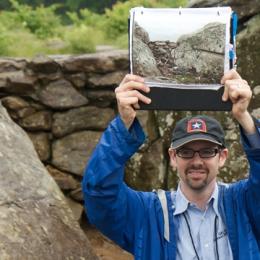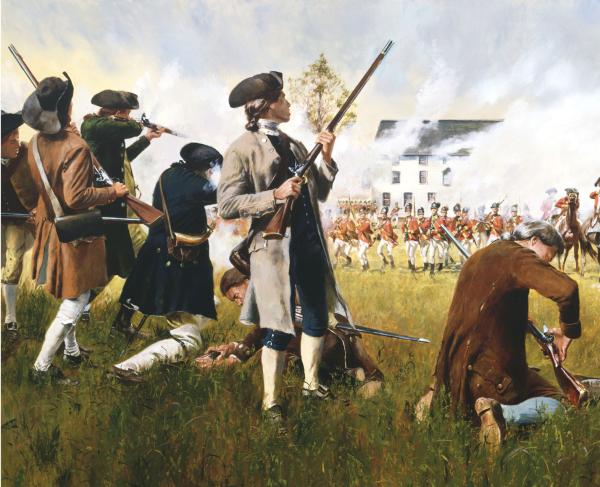American Civil War and Star Wars Parallels

The first words of the opening crawl of the first Star Wars movie released are, "IT IS A PERIOD OF CIVIL WAR." To mark the release of Star Wars - Episode VIII: The Last Jedi, we’ve compiled some of the numerous parallels between the Civil War that happened a century-and-a-half ago in the United States, and the conflict that occurred “a long time ago in a galaxy far, far away…” (Warning: May contain spoilers for both Star Wars and American history. Read at your own risk!)
Famous names from the Galactic Civil War appear surprisingly often in the American Civil War.
While we haven’t been able to find any Skywalkers, Chewbaccas, or R2D2s, we know of at least 29 Civil War soldiers with the surname of “Vader.” Fittingly, none of the Vaders from our galaxy were rebels. What’s more, four of them had the initials “D. Vader.” Among them were Danforth Vader, who served in Company H of the 3rd Pennsylvania Heavy Artillery, and David Winslow Vader, who managed to survive imprisonment at Andersonville.

Also fighting for the Union were several soldiers with the last name of “Solo,” including one Ohioan named Glode Solo who participated in Sherman’s offensive against Atlanta in 1864. There were also several “Snokes,” a number of “George Lucases,” and one soldier from Indianan named Poe E. Stormer.
Kylo Ren is in Steven Spielberg’s 2012 Lincoln.
In a pivotal scene midway through the movie, Daniel Day-Lewis’s Lincoln stops by the War Department and sits down to chat with two young telegraph operators. The President is considering the thorny issue of how best to handle a proposed peace conference with Rebel officials without at the same time derailing his efforts to push the Thirteenth Amendment through Congress. Feeling reflective he asks one of the telegraph operators, Samuel Beckwith, whether he thinks “we choose to be born” or whether we’re “fitted to the times we’re born into?” Beckwith replies that, “I don’t know about myself. You may be, sir. Fitted.” The actor playing Samuel Beckwith was none other than Adam Driver, who was introduced in The Force Awakens as the evil Kylo Ren.

Driver is not the only Lincoln veterans involved with Star Wars. Spielberg’s movie was produced by Kathleen Kennedy, who now serves as the president of Lucasfilm. Lincoln was also scored by legendary Star Wars composer John Williams.
A single artillery piece can change the course of a battle.
At the Battle of Fredericksburg, on the morning of December 13, 1862, Confederate Major John Pelham placed a single cannon on the flank of the advancing Union Army and opened fire. Pelham’s bold maneuver delayed the Federal assault for up to an hour and forced the Yankees to reveal their troop dispositions so as to respond to his gun’s enfilading fire.
via GIPHY
In The Empire Strikes Back, the Rebel Alliance used a single “ion cannon” to disable Darth Vader’s Star Destroyers and buy time to escape from the ice planet Hoth.
Strong women played key roles in both wars.
Just as General Leia, Jyn Erso, and Rey have played central roles in the Star Wars saga, women played vital – although often unheralded – roles in the American Civil War.
In the decades before the Civil War a growing movement for women’s equality developed in the north as an off-shoot of the anti-slavery movement, inspiring countless women to take on increasingly important roles in public life.
Clara Barton, for example, not only tended to wounded soldiers in the midst of ferocious battles, she pressured politicians in Washington to enact reforms to improve army medical care. As the war drew to a close President Lincoln tasked Barton with organizing efforts to determine the fate of missing Union soldiers in southern prison camps. In the 1870s she campaigned for the creation of the American Red Cross, becoming the organization’s first president in 1881.
Families torn apart.
Star Wars is a story about families torn apart by war. In one of the greatest twists in cinematic history, Darth Vader reveals in The Empire Strikes Back that he did not kill Luke Skywalker’s father Anakin. Rather, he is Luke’s father. In Return of the Jedi audiences learned of the existence of “another Skywalker;” Princess Leia was Luke’s long-lost twin-sister.
The American Civil War, of course, is known for turning brother against brother. At the 1862 Battle of Secessionville, for example, brothers James and Alexander Campbell found themselves on opposite sides. Alexander Campbell, a color bearer and sergeant in the 79th New York Volunteer Infantry (known as the Highland Regiment) planted the Stars and Stripes in front of the Rebel parapet, braving enemy fire until given the order to fall back. James Campbell, a Confederate lieutenant, climbed atop that parapet and drove the Federals back by rolling a log down into their midst. After the battle James wrote to Alexander, “I was astonished to hear from the prisoners that you was colour Bearer of the Regmt that assalted the Battrey at this point the other day. When I first heard it I looked over the field for you where I met one of the wounded of your Regt and he told me that he believed you was safe. I was in the Brest work during the whole engagement doing me Best to Beat you but I hope that you and I will never agan meet face to face Bitter enemies in the Battle field. But if such should be the case You have but to discharge your deauty to Your caus for I can assure you I will strive to discharge my deauty to my country & my cause.” Both brothers survived the war and apparently remained in friendly contact.
Blockade running is important in both wars.
The Star Wars saga began in 1977 with a scene that remains iconic to this day: the sight of Princess Leia’s blockade runner trying desperately to outrun a massive Imperial Star Destroyer.
While they never had to dodge turbolasers or escape tractor beams, blockade runners played an important role in the American Civil War. The Confederacy relied on these ships and their daring crews to smuggle value arms and munitions through the United States Navy’s blockade of the South.
Amongst the stars or on the fields of Virginia, battlefield tactics are not particularly useful if they are not aligned with a broader strategic vision.
As every Star Wars fan knows, the Battle of Hoth at the beginning of Episode V was a tactical triumph for Darth Vader and the forces under his command. What fewer recognize, is that the tactics used by the Empire on the ice planet were at cross-purposes with the goal of wiping out the rebellion. By focusing on the capture of territory (the rebel base) rather than the destruction of the enemy’s fighting force, the Empire allowed the Alliance to survive to fight another day.
Just like Vader, both Union and Confederate leaders often focused on achieving tactical victories without considering the larger strategic context in which they were operating. Robert E. Lee, for example, is rightly hailed for his tactical genius, but the same audacity and aggression on the battlefield that secured him a string of victories over the Army of the Potomac required his army to incur heavy losses the Confederacy could ill afford.
Both have a Grand Army of the Republic.
Founded in 1866, the Grand Army of the Republic was a fraternal organization for Union veterans that at its peak included almost half-a-million members. Dedicated to upholding the principles for which they had fought, GAR members both white and black advocated for the cause of civil rights while also campaigning to secure veteran pensions.
Less admirable was the Grand Army of the Republic created by Supreme Chancellor Palpatine in Attack of the Clones, ostensibly to counter the threat posed by Count Dooku’s droid army. As revealed in Revenge of the Sith, that army’s real purpose was the destruction of the Jedi Order.




